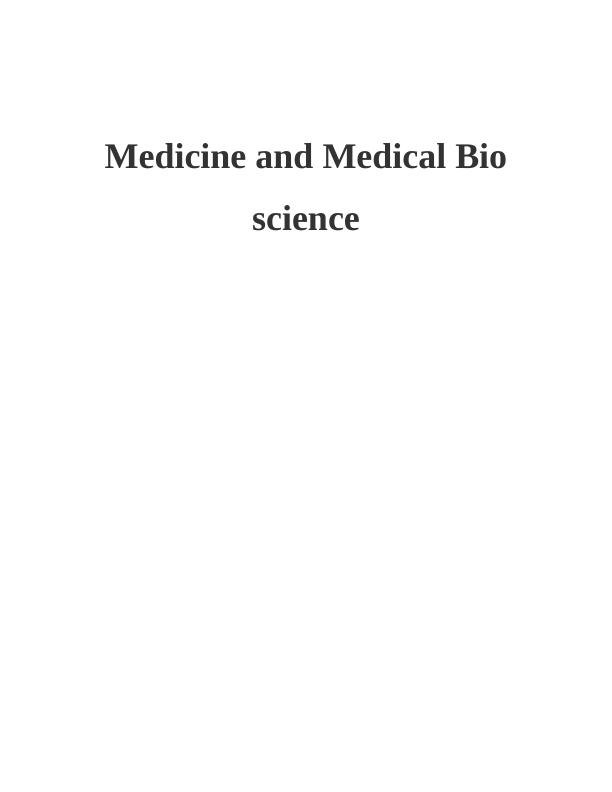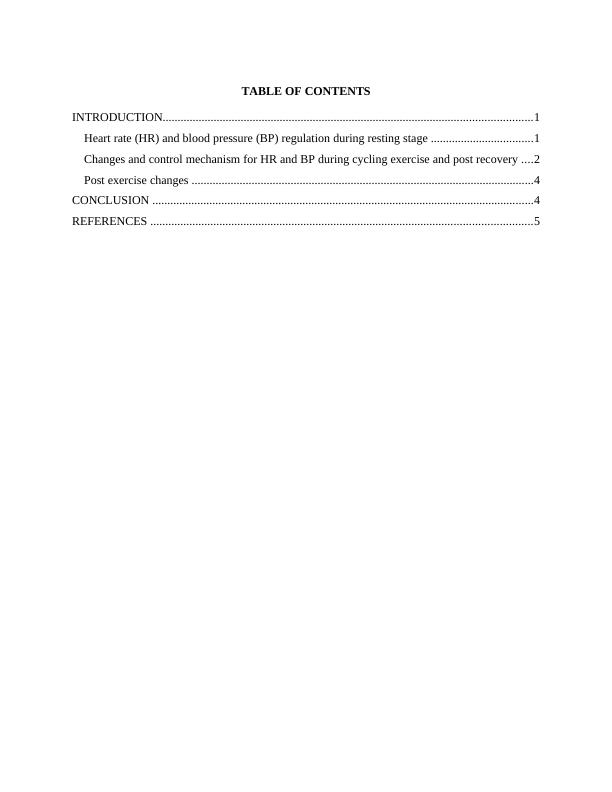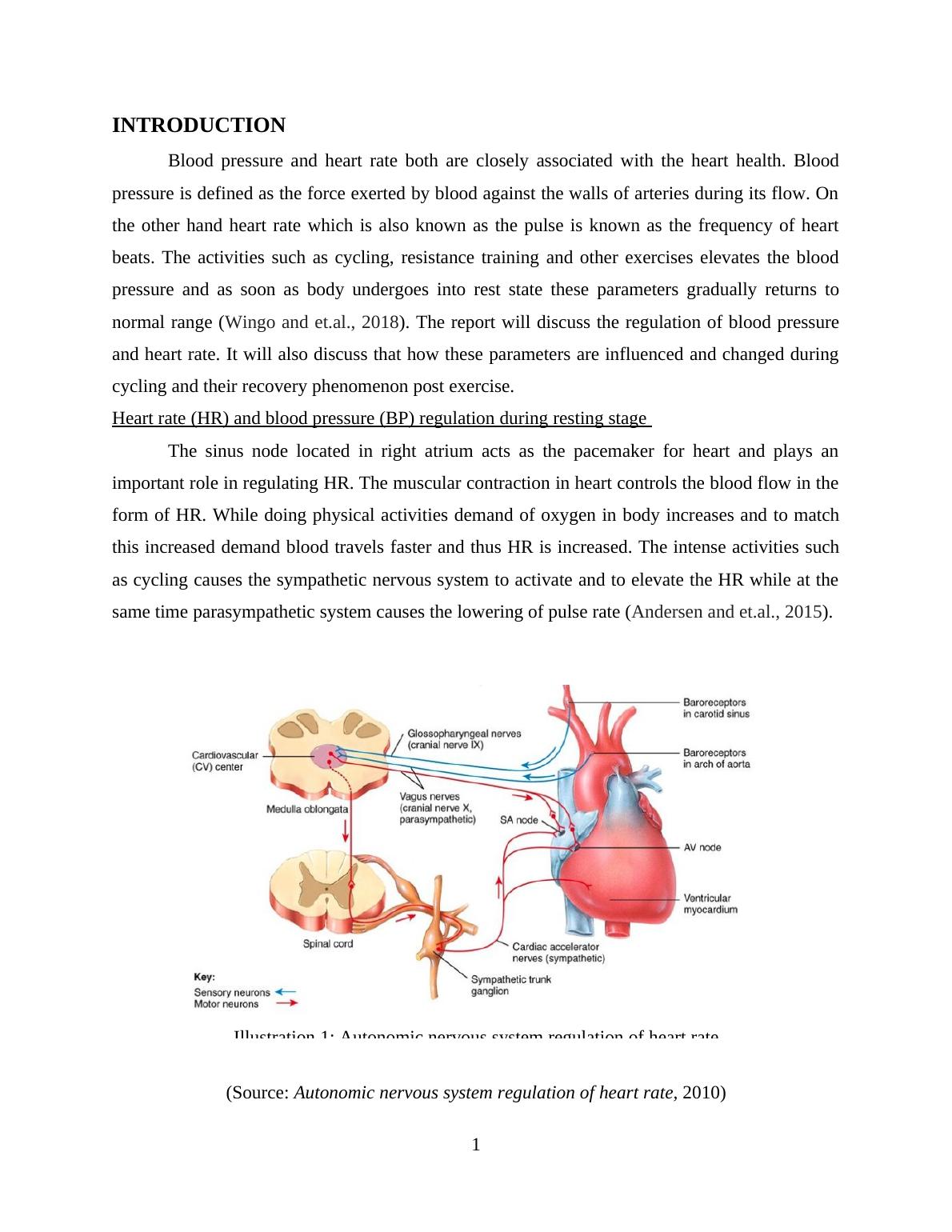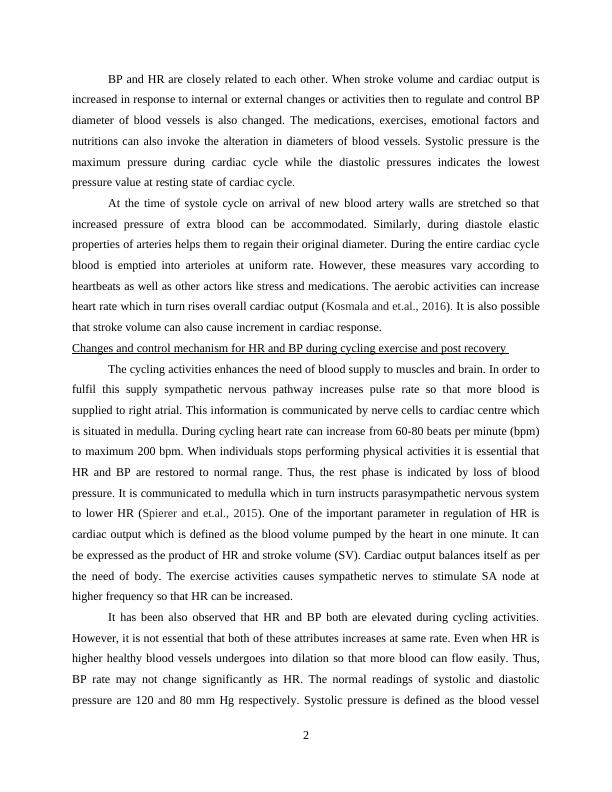Medical Science Assignment (Doc)
12 Pages2073 Words64 Views
Added on 2020-12-26
Medical Science Assignment (Doc)
Added on 2020-12-26
ShareRelated Documents
Medicine and Medical Bio
science
science

TABLE OF CONTENTS
INTRODUCTION...........................................................................................................................1
Heart rate (HR) and blood pressure (BP) regulation during resting stage ..................................1
Changes and control mechanism for HR and BP during cycling exercise and post recovery ....2
Post exercise changes ..................................................................................................................4
CONCLUSION ...............................................................................................................................4
REFERENCES ...............................................................................................................................5
INTRODUCTION...........................................................................................................................1
Heart rate (HR) and blood pressure (BP) regulation during resting stage ..................................1
Changes and control mechanism for HR and BP during cycling exercise and post recovery ....2
Post exercise changes ..................................................................................................................4
CONCLUSION ...............................................................................................................................4
REFERENCES ...............................................................................................................................5

INTRODUCTION
Blood pressure and heart rate both are closely associated with the heart health. Blood
pressure is defined as the force exerted by blood against the walls of arteries during its flow. On
the other hand heart rate which is also known as the pulse is known as the frequency of heart
beats. The activities such as cycling, resistance training and other exercises elevates the blood
pressure and as soon as body undergoes into rest state these parameters gradually returns to
normal range (Wingo and et.al., 2018). The report will discuss the regulation of blood pressure
and heart rate. It will also discuss that how these parameters are influenced and changed during
cycling and their recovery phenomenon post exercise.
Heart rate (HR) and blood pressure (BP) regulation during resting stage
The sinus node located in right atrium acts as the pacemaker for heart and plays an
important role in regulating HR. The muscular contraction in heart controls the blood flow in the
form of HR. While doing physical activities demand of oxygen in body increases and to match
this increased demand blood travels faster and thus HR is increased. The intense activities such
as cycling causes the sympathetic nervous system to activate and to elevate the HR while at the
same time parasympathetic system causes the lowering of pulse rate (Andersen and et.al., 2015).
(Source: Autonomic nervous system regulation of heart rate, 2010)
1
Illustration 1: Autonomic nervous system regulation of heart rate
Blood pressure and heart rate both are closely associated with the heart health. Blood
pressure is defined as the force exerted by blood against the walls of arteries during its flow. On
the other hand heart rate which is also known as the pulse is known as the frequency of heart
beats. The activities such as cycling, resistance training and other exercises elevates the blood
pressure and as soon as body undergoes into rest state these parameters gradually returns to
normal range (Wingo and et.al., 2018). The report will discuss the regulation of blood pressure
and heart rate. It will also discuss that how these parameters are influenced and changed during
cycling and their recovery phenomenon post exercise.
Heart rate (HR) and blood pressure (BP) regulation during resting stage
The sinus node located in right atrium acts as the pacemaker for heart and plays an
important role in regulating HR. The muscular contraction in heart controls the blood flow in the
form of HR. While doing physical activities demand of oxygen in body increases and to match
this increased demand blood travels faster and thus HR is increased. The intense activities such
as cycling causes the sympathetic nervous system to activate and to elevate the HR while at the
same time parasympathetic system causes the lowering of pulse rate (Andersen and et.al., 2015).
(Source: Autonomic nervous system regulation of heart rate, 2010)
1
Illustration 1: Autonomic nervous system regulation of heart rate

BP and HR are closely related to each other. When stroke volume and cardiac output is
increased in response to internal or external changes or activities then to regulate and control BP
diameter of blood vessels is also changed. The medications, exercises, emotional factors and
nutritions can also invoke the alteration in diameters of blood vessels. Systolic pressure is the
maximum pressure during cardiac cycle while the diastolic pressures indicates the lowest
pressure value at resting state of cardiac cycle.
At the time of systole cycle on arrival of new blood artery walls are stretched so that
increased pressure of extra blood can be accommodated. Similarly, during diastole elastic
properties of arteries helps them to regain their original diameter. During the entire cardiac cycle
blood is emptied into arterioles at uniform rate. However, these measures vary according to
heartbeats as well as other actors like stress and medications. The aerobic activities can increase
heart rate which in turn rises overall cardiac output (Kosmala and et.al., 2016). It is also possible
that stroke volume can also cause increment in cardiac response.
Changes and control mechanism for HR and BP during cycling exercise and post recovery
The cycling activities enhances the need of blood supply to muscles and brain. In order to
fulfil this supply sympathetic nervous pathway increases pulse rate so that more blood is
supplied to right atrial. This information is communicated by nerve cells to cardiac centre which
is situated in medulla. During cycling heart rate can increase from 60-80 beats per minute (bpm)
to maximum 200 bpm. When individuals stops performing physical activities it is essential that
HR and BP are restored to normal range. Thus, the rest phase is indicated by loss of blood
pressure. It is communicated to medulla which in turn instructs parasympathetic nervous system
to lower HR (Spierer and et.al., 2015). One of the important parameter in regulation of HR is
cardiac output which is defined as the blood volume pumped by the heart in one minute. It can
be expressed as the product of HR and stroke volume (SV). Cardiac output balances itself as per
the need of body. The exercise activities causes sympathetic nerves to stimulate SA node at
higher frequency so that HR can be increased.
It has been also observed that HR and BP both are elevated during cycling activities.
However, it is not essential that both of these attributes increases at same rate. Even when HR is
higher healthy blood vessels undergoes into dilation so that more blood can flow easily. Thus,
BP rate may not change significantly as HR. The normal readings of systolic and diastolic
pressure are 120 and 80 mm Hg respectively. Systolic pressure is defined as the blood vessel
2
increased in response to internal or external changes or activities then to regulate and control BP
diameter of blood vessels is also changed. The medications, exercises, emotional factors and
nutritions can also invoke the alteration in diameters of blood vessels. Systolic pressure is the
maximum pressure during cardiac cycle while the diastolic pressures indicates the lowest
pressure value at resting state of cardiac cycle.
At the time of systole cycle on arrival of new blood artery walls are stretched so that
increased pressure of extra blood can be accommodated. Similarly, during diastole elastic
properties of arteries helps them to regain their original diameter. During the entire cardiac cycle
blood is emptied into arterioles at uniform rate. However, these measures vary according to
heartbeats as well as other actors like stress and medications. The aerobic activities can increase
heart rate which in turn rises overall cardiac output (Kosmala and et.al., 2016). It is also possible
that stroke volume can also cause increment in cardiac response.
Changes and control mechanism for HR and BP during cycling exercise and post recovery
The cycling activities enhances the need of blood supply to muscles and brain. In order to
fulfil this supply sympathetic nervous pathway increases pulse rate so that more blood is
supplied to right atrial. This information is communicated by nerve cells to cardiac centre which
is situated in medulla. During cycling heart rate can increase from 60-80 beats per minute (bpm)
to maximum 200 bpm. When individuals stops performing physical activities it is essential that
HR and BP are restored to normal range. Thus, the rest phase is indicated by loss of blood
pressure. It is communicated to medulla which in turn instructs parasympathetic nervous system
to lower HR (Spierer and et.al., 2015). One of the important parameter in regulation of HR is
cardiac output which is defined as the blood volume pumped by the heart in one minute. It can
be expressed as the product of HR and stroke volume (SV). Cardiac output balances itself as per
the need of body. The exercise activities causes sympathetic nerves to stimulate SA node at
higher frequency so that HR can be increased.
It has been also observed that HR and BP both are elevated during cycling activities.
However, it is not essential that both of these attributes increases at same rate. Even when HR is
higher healthy blood vessels undergoes into dilation so that more blood can flow easily. Thus,
BP rate may not change significantly as HR. The normal readings of systolic and diastolic
pressure are 120 and 80 mm Hg respectively. Systolic pressure is defined as the blood vessel
2

End of preview
Want to access all the pages? Upload your documents or become a member.
Related Documents
Blood Pressure: Effects of Posture on Arterial Blood Pressurelg...
|7
|1332
|57
Physiology Report Baroreceptorslg...
|8
|1668
|197
Exercise Physiology Assignment PDFlg...
|14
|2790
|60
Effect of short-term exercise on cardiovascular, respiratory and muscular systemslg...
|12
|2808
|171
Assignment On The Respiratorylg...
|9
|2323
|16
Respiratory and Circulatory Systems PDFlg...
|6
|1336
|23
